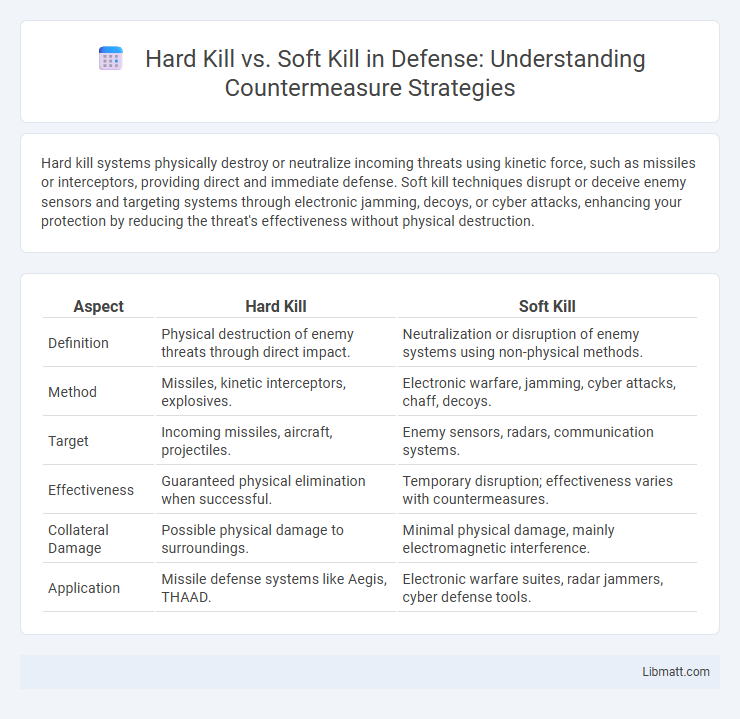Hard kill systems physically destroy or neutralize incoming threats using kinetic force, such as missiles or interceptors, providing direct and immediate defense. Soft kill techniques disrupt or deceive enemy sensors and targeting systems through electronic jamming, decoys, or cyber attacks, enhancing your protection by reducing the threat's effectiveness without physical destruction.
Table of Comparison
| Aspect | Hard Kill | Soft Kill |
|---|---|---|
| Definition | Physical destruction of enemy threats through direct impact. | Neutralization or disruption of enemy systems using non-physical methods. |
| Method | Missiles, kinetic interceptors, explosives. | Electronic warfare, jamming, cyber attacks, chaff, decoys. |
| Target | Incoming missiles, aircraft, projectiles. | Enemy sensors, radars, communication systems. |
| Effectiveness | Guaranteed physical elimination when successful. | Temporary disruption; effectiveness varies with countermeasures. |
| Collateral Damage | Possible physical damage to surroundings. | Minimal physical damage, mainly electromagnetic interference. |
| Application | Missile defense systems like Aegis, THAAD. | Electronic warfare suites, radar jammers, cyber defense tools. |
Understanding Hard Kill and Soft Kill: Definitions
Hard kill refers to physical destruction or direct neutralization of a target using weapons such as missiles, guns, or explosives, ensuring complete elimination. Soft kill involves electronic warfare, cyber attacks, or other non-physical methods like jamming, spoofing, or disrupting enemy sensors and communications to incapacitate without causing physical damage. Both methods serve strategic roles in modern defense systems, with hard kill providing kinetic action and soft kill enabling tactical disruption.
Historical Context of Kill Mechanisms
Hard kill and soft kill mechanisms emerged during the Cold War era as responses to escalating missile threats, with hard kill systems designed to physically destroy incoming projectiles through kinetic or explosive force. Soft kill techniques evolved to incapacitate or confuse enemy sensors and guidance systems using electronic jamming, decoys, or directed energy, reducing reliance on direct interception. Advances in radar technology and missile guidance have continuously shaped the strategic development of these kill methods in modern defense architectures.
Key Differences Between Hard Kill and Soft Kill
Hard kill defense systems physically intercept and destroy incoming threats, such as missiles or projectiles, using kinetic force or explosives. Soft kill methods employ electronic warfare techniques, including jamming, decoys, and deception, to disrupt or mislead the enemy targeting systems without direct destruction. Key differences lie in the approach: hard kill neutralizes threats through physical impact, while soft kill focuses on electronic suppression and avoidance tactics.
Technologies Used in Hard Kill Systems
Hard kill systems utilize advanced technologies such as kinetic interceptors, radar-guided missiles, and high-velocity projectiles to physically destroy incoming threats. These systems often integrate radar tracking, infrared sensors, and laser guidance for precise target acquisition and engagement. Your defense infrastructure benefits from hard kill technologies by providing active neutralization of hostile projectiles before impact.
Technologies Used in Soft Kill Systems
Soft kill systems primarily utilize electronic warfare technologies such as jammers, decoys, and infrared countermeasures to disrupt or mislead incoming threats without physical destruction. These technologies include radar jamming equipment that emits signals to confuse enemy radar, and infrared flares that divert heat-seeking missiles away from the target. Sophisticated signal processing and directional antennas enhance the effectiveness of these soft kill measures by precisely targeting and neutralizing adversary tracking systems.
Advantages of Hard Kill Solutions
Hard kill solutions provide direct physical destruction of incoming threats, ensuring immediate neutralization with high reliability. These systems enhance defense capabilities by minimizing chances of evasion or countermeasures, delivering decisive protection against missiles, drones, and projectiles. Their rapid response and precise targeting reduce collateral damage, increasing overall battlefield effectiveness and safety.
Benefits of Soft Kill Strategies
Soft kill strategies offer the advantage of disrupting or deceiving enemy sensors and communications without physical destruction, preserving assets and reducing collateral damage. These methods enhance battlefield survivability by causing confusion and impairing the opponent's decision-making processes. You can maintain operational flexibility and minimize escalation risks through effective electronic warfare, cyber tactics, and jamming techniques.
Integration of Hard and Soft Kill in Modern Defense
Modern defense systems achieve optimal protection by integrating hard kill and soft kill technologies, combining physical interception with electronic countermeasures. Hard kill methods neutralize threats through direct destruction using missiles or kinetic projectiles, while soft kill techniques disrupt or deceive enemy sensors and targeting systems via jamming and decoys. Your defense strategy benefits significantly from this layered approach, enhancing survivability against diverse and advanced threats in complex combat environments.
Challenges and Limitations of Each Approach
Hard kill systems face challenges such as the high cost of interceptors, limited ammunition, and difficulty in targeting fast or maneuverable threats, which can reduce effectiveness in saturated attack scenarios. Soft kill techniques, including electronic jamming and decoys, risk countermeasures by sophisticated adversaries and may fail against stealth or autonomous weapons that rely less on electronic signals. Your defense strategy must consider these limitations to balance physical destruction and electronic disruption for optimal protection.
Future Trends in Kill Mechanism Development
Future trends in kill mechanism development emphasize integrating artificial intelligence with hard kill and soft kill systems to enhance target detection and response speed. Research focuses on hybrid solutions combining kinetic interceptors and electronic warfare techniques to neutralize threats more efficiently. Your defense strategy will benefit from advancements enabling adaptive, multi-layered protection against emerging missile and drone technologies.
hard kill vs soft kill Infographic

 libmatt.com
libmatt.com